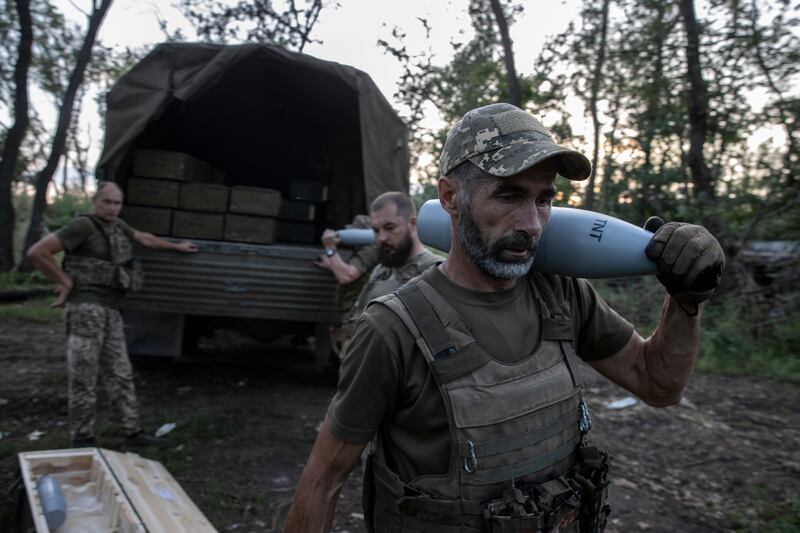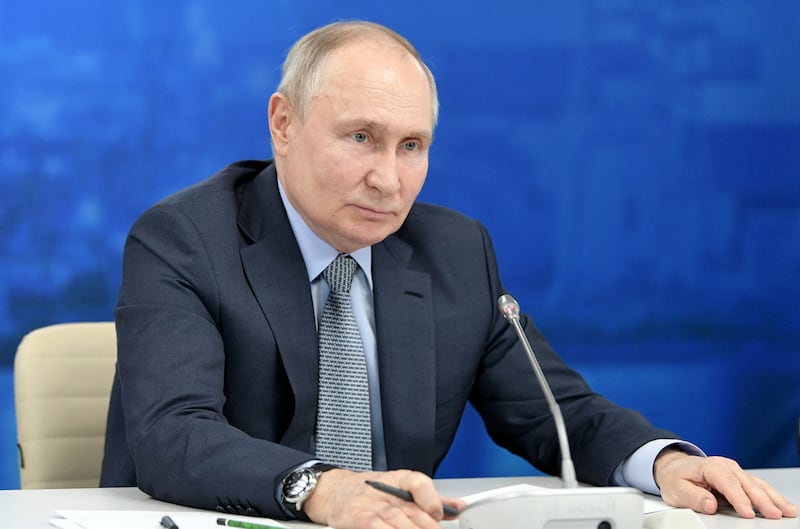On all fronts of the Ukraine-Russia war – from the freezing trenches of Donbas to cyberspace, and from ammunition factories to diplomatic gatherings – Moscow is cranking up pressure on Kyiv.
The political rows now halting vital US and EU funding for Kyiv confirm a core Kremlin belief that the West will not stomach a long war in Ukraine – even though it is not doing the fighting – and they make Ukrainians feel like they are battling for survival with one arm tied behind their back and one eye on the enemy and the other on their irresolute allies.
The Ukrainian army must now consider rationing ammunition in line with dwindling supply, and it is now firing just 2,000 shells per day along the 1,000km front line – more than three times fewer than during its failed counteroffensive of last summer, and barely one-fifth of Russia’s current daily rate.
Russia says its industry is on a war footing and domestic production of weapons and ammunition is climbing. North Korea is also now providing ballistic missiles to Moscow, which has enjoyed ample supplies of explosive “Shahed” attack drones from its ally Iran since the start of its full-scale invasion of Ukraine in February 2022.
READ MORE
Meanwhile, the Pentagon says that without more money from the US Congress it cannot afford to resupply Kyiv or even fund repairs to weapons already delivered, and the EU has delivered only about a third of the 1 million artillery shells that it pledged to send Kyiv by early this year.
[ Russia-Ukraine war: Moscow and Kyiv trade accusations over fatal crash of planeOpens in new window ]
[ State may suspend signing of new hotel contracts for Ukrainians as arrivals dropOpens in new window ]
The strain is growing, but Ukraine’s supply problems have not yet translated into significant losses on the battlefield.
The most recent major gain for either side was Russia’s occupation of the eastern city of Bakhmut last May, and that came at a big cost – the loss to death and injury of tens of thousands of Russian troops and mercenaries, and the almost total destruction of the former transport hub in the Donetsk region.

Russia is now pushing hard to retake the town of Kupiansk in Kharkiv region, which Ukraine freed in late 2022, and to seize Avdiivka, 70km south of Bakhmut. This industrial town is effectively a suburb of Donetsk, a city held by Kremlin-led militants since 2014, and Russia’s failure to take it is a striking example of Ukraine’s doggedness and the inability of Moscow’s military to make what it surely assumed would be easy gains in an all-out war.
Ukraine’s hold on Avdiivka has been strengthened by extensive fortifications built since fighting began in Donbas a decade ago, and President Volodymyr Zelenskiy has now ordered a large construction effort to stiffen the entire Ukrainian line with trenches, minefields and anti-tank installations, as his forces switch to a defensive posture.
These high-profile attacks also boost Ukraine’s morale during a winter of near-stalemate on the battlefield and deadly missile strikes on its cities
Ukraine’s troops will be braced for an onslaught before Russia’s presidential election in March – when victory for veteran autocrat Vladimir Putin is assured – but Kyiv officials say they cannot just dig in and weather the storm, and risk creating a “frozen conflict” that would give Moscow’s military time to recover, rearm and attack again.

Kyiv intends to target Russian weak spots whenever it can, on the ground, at sea and in the air, having already inflicted heavy damage on Moscow’s Black Sea Fleet, based at Sevastopol in occupied Crimea, using western-supplied missiles and Ukrainian-made drones.
Big Russian fuel facilities in St Petersburg, Bryansk and Tuapse were set on fire by drone strikes this month, and an advanced Russian Beriev A-50 early-warning radar plane was shot down and an Il-22 aerial command post badly damaged while flying near Crimea.
Operations like these show that Ukraine can make good use of its whole arsenal – from relatively cheap drones built by its own engineers to multimillion-dollar US missiles – and that innovation, adaptability and western help allow it to inflict costly and disruptive damage on an enemy with far more manpower and military resources.
The Kremlin would also like to foment discord in Ukraine, where politicians are debating how best to bring hundreds of thousands more people into the army now that the pool of volunteers has dried up
These high-profile attacks also boost Ukraine’s morale during a winter of near-stalemate on the battlefield and deadly missile strikes on its cities, and may make some Russians at all levels think again about the wisdom of Putin’s invasion.
Moscow’s chief hope is that foreign backing for Ukraine will crumble, and Russian officials, diplomats and media are working hard to undermine the West’s faith in Kyiv.
In the past week alone, Russia has claimed that a band of French mercenaries and an Italian military officer were killed in Ukraine; that US weapons supplied to Kyiv are being sold via the dark web in Asia, Africa and Latin America; and that a western air defence system downed a Russian military Il-76 plane near the border city of Belgorod, allegedly killing dozens of Ukrainian prisoners of war (POWs) on-board.
Moscow offered no evidence for the claims, but hopes they will be regurgitated in the relevant states by politicians and commentators who want to stop helping Ukraine and rebuild ties with Russia.
The Kremlin would also like to foment discord in Ukraine, where politicians are debating how best to bring hundreds of thousands more people into the army now that the pool of volunteers has dried up – a deeply sensitive issue, made more divisive by near-daily revelations of corrupt officials taking bribes to help people dodge military service.
“The main focus with the Il-76 incident was the alleged use of American weapons. Russia’s consistent information attacks aim to derail Ukraine’s security agreements with western countries and disrupt arms supplies. This is their primary objective, and they are actively exploiting it,” analyst Taras Zagorodniy told Ukraine’s RadioNV.
“As for the claims that Ukrainian POWs were on the Il-76, this is targeted at the Ukrainian audience ... to consolidate all the accumulated grievances of Ukrainians, they struck a sensitive point like POWs. I don’t think it was unplanned. But the main goal is to disrupt the supply of weapons to Ukraine.”
- Sign up for push alerts and have the best news, analysis and comment delivered directly to your phone
- Find The Irish Times on WhatsApp and stay up to date
- Our In The News podcast is now published daily – Find the latest episode here





















